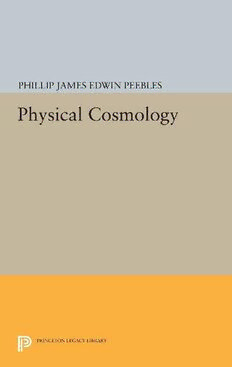
Physical Cosmology PDF
Preview Physical Cosmology
Physical Cosmology Physical Cosmology BY P. J.E. PEEBLES Princeton Series in Physics Princeton University Press Princeton, New Jersey · 1971 Copyrigh©t 1971, PrincetUonni versPirteys s by ALL RIGHTS RESERVED L.C.C ard:7 4-181520 ISBN0- 691-0088-5( paperbaecdkn .) l ISBN0 -691-0813(7h-a9r dcoveedrn .) SeconPdr inting1,9 74 Printiendt heU niteSdt ateosfA merica byP rincetUonni versPirteys s To Alison INTRODUCTION Physical science more often than not violates the rule that familiarity breeds contempt. We may be assured that we have a reasonable under standing of the atmosphere of Mars, the major constituents, the temperature and pressure, yet we know very well that it is hard to say whether it will rain tomorrow. This does not mean that we understand the Martian atmos phere better than our own. Quite the contrary, we have incomparably better observational material on the Earth's atmosphere so we can and should ask much more detailed and deeper questions about it. Sometimes this order may be bent because greater physical simplicity can overweigh better data. For all the wealth of evidence on the center of the Earth from seismic data, free oscillations, heat flux, and gravitational anomalies, to say nothing of hard rock geology, it could be that we understand the center of the Sun better than the center of the Earth just because the ideal gas law is a good approxi mation for the Sun. In cosmology the reliance on physical simplicity, pure thought and re vealed knowledge is carried well beyond the fringe because we have so little else to go on. By this desperate course we have arrived at a few simple pictures of what the Universe may be like. The great goal now is to become more familiar with the Universe, to learn whether any of these pictures may be a reasonable approximation, and if so how the approxima tion may be improved. The great excitement in cosmology is that the pros pects for doing this seem to be excellent. On one front we have some ex plicit questions, like the shapes of the redshift-magnitude relation and the redshift-angular size relation, and the values of some elementary parameters like Hubble's constant and the mean mass density. Probably we will only know for sure whether these questions are clever after we vii viii INTRODUCTION understand the answers, but at least we can see how available technologi cal developments can be turned to powerful new attacks on them. A second exciting front is the search for new phenomena that may or may not inter connect in a pleasant way with accepted ideas. Of course we have no plan for finding these nuggets, only the expectation based on past form that as "' techniques of observation develop and extend our view we are liable to stumble on them. The goal of these notes is to aid this advance of cosmology by providing a guide, mainly for the experimentalist or observer, to the popular questions and answers in the subject. While there is no shortage of questions it is true that I have restricted the list to the orthodox questions in an establish ment cosmology. There is the point of view that in a science as primitive as cosmology one ought to avoid orthodoxy, give equal time to all competing cosmologies. The first problem is that one could never hope to think of all reasonably possible views people might want to consider. Second there is the danger that the approach will degenerate into long lists of alternative possibilities, from which the reader can understand where we are only with the help of an auxiliary guide. My own preference is to make a subjective selection of a reasonably possible cosmology, and then study it in all the detail one can muster. The end result of such an effort may be to reveal that the cosmology is logically inconsistent or even in conflict with ob servation, which is progress of a sort. The hope is that the development of the observations may convince us of the rough validity of the chosen cosmolog}', and guide us to how the cosmology should evolve. Consistent with this view the Cosmological Constant is seldom /\ mentioned in these notes because a non-zero can do only two essentially /\ different things. If is less than zero, or positive but not too large, it /\ alters somewhat the connection among expansion rate, mass density and curvature in the present Universe, and it hardly at all affects the expansion rate in the early Universe. We gain one more parameter, but we already had more than we can fix. The second possibility is more interesting - if were large enough it would eliminate the Big Bang, the singular infinite /\
